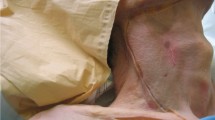Abstract
Purpose
An ideal way to treat osteoradionecrosis of the jaws is to transfer an osteogenic, appropriately vascularized flap to the affected site. The corticoperiosteal femoral medial supracondylar flap is being used increasingly in the treatment of complex pseudarthrosis of long bones, but is yet to find robust indications for use in the treatment of osteoradionecrosis of the jaw, the reasons being a lack of anatomical data concerning its vascular supply and the local constraints of its routine harvest. This study presents an anatomical study and literature review to explore its potentials in clinical practice.
Materials and methods
A total of 25 legs were dissected following vascular injection of colored neopren. The descending genicular artery (DGA) and veins were studied with particular attention paid to anatomical variations found in their branches. Calibers and length of the vessels were recorded.
Results
Many anatomical variations of the DGA were found and a classification proposed. The mean caliber of the DGA at the origin was 1.9 mm, and for the vein, 1.8 mm. The mean useful length of the pedicle was 7.9 cm. A case is reported.
Conclusion
A clear anatomical knowledge (and, therefore, a sound classification system to grade flap harvesting potential) is the key first step prior to extensive clinical use of this flap. Various anatomical patterns of the pedicle are frequently encountered; branches can be elusive when raising the flap. Vascular imaging is therefore a critical step in identifying types and subtypes before surgery.




Similar content being viewed by others
References
Ballmer FT, Masquelet AC (1998) The reversed-flow medio-distal fasciocutaneous island thigh flap: anatomic basis and clinical applications. Surg Radiol Anat 20:311–316
Burstein FD, Canalis RF (1985) Studies on the osteogenic potential of vascularized periosteum: behavior of periosteal flaps transferred onto soft tissues. Otolaryngol Head Neck Surg 93:731–735
Camilli JA, Penteado CV (1994) Bone formation by vascularized periosteal and osteoperiosteal grafts. An experimental study in rats. Arch Orthop Trauma Surg 114:18–24
Cavadas PC, Landin L (2008) Treatment of recalcitrant distal tibial nonunion using the descending genicular corticoperiosteal free flap. J Trauma 64:144–150
Choudry UH, Bakri K, Moran SL et al (2008) The vascularized medial femoral condyle periosteal bone flap for the treatment of recalcitrant bony nonunions. Ann Plast Surg 60:174–180
D’Hauthuille C, Testelin S, Taha F et al (2009) Part III: free periosteal flaps as a treatment for mandibular osteoradionecrosis. Rev Stomatol Chir Maxillofac 110:3–7
Dambrain R (1993) The pathogenesis of osteoradionecrosis. Rev Stomatol Chir Maxillofac 94:140–147
Devauchelle B, Testelin S, Bonan C, Souaid G (1998) Secondary reconstruction after transmandibular buccopharyngectomy with bone resection and after radionecrosis. Rev Stomatol Chir Maxillofac 99:22–37
Doi K, Sakai K (1994) Vascularized periosteal bone graft from the supracondylar region of the femur. Microsurgery 15:305–315
Finley JM, Acland RD, Wood MB (1978) Revascularized periosteal grafts—a new method to produce functional new bone without bone grafting. Plast Reconstr Surg 61:1–6
Hertel R, Masquelet AC (1989) The reverse flow medial knee osteoperiosteal flap for skeletal reconstruction of the leg. Description and anatomical basis. Surg Radiol Anat 11:257–262
Kaminski A, Bürger H, Müller EJ (2008) Free vascularised corticoperiosteal bone flaps in the treatment of non-union of long bones: an ignored opportunity? Acta Orthop Belg 74:235–239
King KF (1976) Periosteal pedicle grafting in dogs. J Bone Joint Surg Br 58:117–121
Martin D, Bitonti-Grillo C, De Biscop J et al (1991) Mandibular reconstruction using a free vascularised osteocutaneous flap from the internal condyle of the femur. Br J Plast Surg 44:397–402
Marx RE (1983) Osteoradionecrosis: a new concept of its pathophysiology. J Oral Maxillofac Surg 41:283–288
Masquelet AC, Romana MC, Penteado CV, Carlioz H (1988) Vascularized periosteal grafts. Anatomic description, experimental study, preliminary report of clinical experience. Rev Chir Orthop Reparatrice Appar Mot 74(suppl 2):240–243
Muramatsu K, Doi K, Ihara K et al (2003) Recalcitrant posttraumatic nonunion of the humerus: 23 patients reconstructed with vascularized bone graft. Acta Orthop Scand 74:95–97
Ollier L (1867) Traité expérimental et clinique de la régénération des os et de la production artificielle du tissu osseux. Masson, Paris
Penteado CV, Masquelet AC, Romana MC, Chevrel JP (1990) Periosteal flaps: anatomical bases of sites of elevation. Surg Radiol Anat 12:3–7
Sakai K, Doi K, Kawai S (1991) Free vascularized thin corticoperiosteal graft. Plast Reconstr Surg 87:290–298
Scheibel MT, Schmidt W, Thomas M, von Salis-Soglio G (2002) A detailed anatomical description of the subvastus region and its clinical relevance for the subvastus approach in total knee arthroplasty. Surg Radiol Anat 24:6–12
Takato T, Harii K, Nakatsuka T et al (1986) Vascularized periosteal grafts: an experimental study using two different forms of tibial periosteum in rabbits. Plast Reconstr Surg 78:489–497
Thurmüller P, Kesting MR, Hölzle F et al (2007) Volume-rendered three-dimensional spiral computed tomographic angiography as a planning tool for microsurgical reconstruction in patients who have had operations or radiotherapy for oropharyngeal cancer. Br J Oral Maxillofac Surg 45:543–547
Trueta J, Cavadias AX (1955) Vascular changes caused by the Kuntscher type of nailing; an experimental study in the rabbit. J Bone Joint Surg Br 37-B:492–505
Tubbs RS, Loukas M, Shoja MM et al (2007) Anatomy and potential clinical significance of the vastoadductor membrane. Surg Radiol Anat 29:569–573
Yajima H, Tamai S, Ono H, Kizaki K (1998) Vascularized bone grafts to the upper extremities. Plast Reconstr Surg 101:727–735 discussion 736–727
Yajima H, Maegawa N, Ota H et al (2007) Treatment of persistent non-union of the humerus using a vascularized bone graft from the supracondylar region of the femur. J Reconstr Microsurg 23:107–113
Author information
Authors and Affiliations
Corresponding author
Rights and permissions
About this article
Cite this article
Dubois, G., Lopez, R., Puwanarajah, P. et al. The corticoperiosteal medial femoral supracondylar flap: anatomical study for clinical evaluation in mandibular osteoradionecrosis. Surg Radiol Anat 32, 971–977 (2010). https://doi.org/10.1007/s00276-010-0658-9
Received:
Accepted:
Published:
Issue Date:
DOI: https://doi.org/10.1007/s00276-010-0658-9




